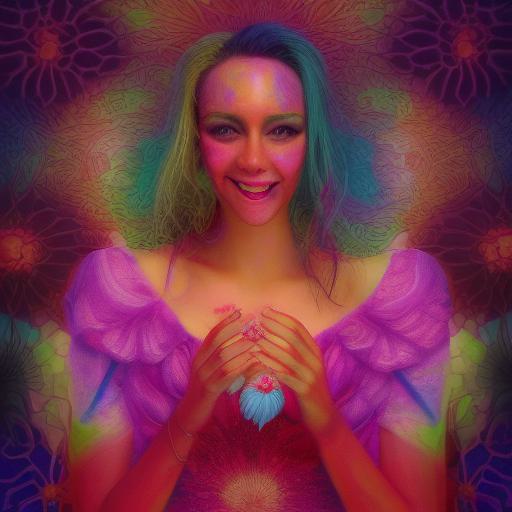How to write this prompt?
Here is a breakdown of the AI image prompt and how each individual part influences the image being generated:
- Digital Psychedelic Painting: This sets the overall style of the image. The AI will be prompted to create a painting-style image that is vibrant, colorful, and surreal.
- Inspired by Amanda Sage: This provides a reference point for the AI. Amanda Sage’s work is known for its otherworldly feel and use of bright colors, so the AI will be prompted to incorporate these elements into the image.
- Artstation Contest Winner: This indicates that the image should be of high quality and visually striking. The AI will be encouraged to create an image that is not only aesthetically pleasing but also stands out from the crowd.
- Woman with Laughing Flower in her Hand: This provides a focal point for the image. The AI will be prompted to create an image that centers around a woman holding a flower that is either laughing or has a personified expression.
- Predominantly Purple and Pink with Some Teal and Magenta Accents: This sets the color scheme of the image. The AI will be encouraged to use these specific colors to create a harmonious and cohesive color palette.
- Panoramic View: This sets the composition of the image. The AI will be prompted to create an image that has a wide-angle view, allowing for a sense of depth and immersion.
- Bokeh and Studio Quality Lighting: This sets the lighting style of the image. The AI will be encouraged to create a mix of bokeh and studio lighting, resulting in a dreamy and magical feel.
Overall, each individual part of the prompt contributes to the final image generated by the AI. By providing specific details on the style, composition, colors, and lighting, the prompt is able to guide the AI towards creating an image that meets the desired aesthetic and artistic goals.
What is the significance of the bokeh effect in photography?
The bokeh effect in photography refers to the aesthetic quality of the blur produced in the out-of-focus parts of an image. This effect is often achieved by using a lens with a large aperture and results in a soft and dreamy background. The significance of the bokeh effect is that it can help draw attention to the main subject of the photograph by creating a visual separation between the subject and the background.
How to create a digital psychedelic painting like Amanda Sage?
To create a digital psychedelic painting like Amanda Sage, you will need to use digital art software such as Adobe Photoshop, Procreate, or Corel Painter. Start by choosing a vibrant color palette and incorporating surreal elements such as distorted shapes, patterns, and symbols. Experiment with different brushes and techniques to create a layered and textured look. To add depth and immersion, use a panoramic view and play with lighting and shadow effects.
Why is Amanda Sage’s artwork considered otherworldly?
Amanda Sage’s artwork is considered otherworldly because of its use of vibrant colors, surreal imagery, and spiritual themes. Her paintings often feature human figures or faces that are distorted or fragmented, giving a sense of the inner workings of the mind or the spirit. She draws inspiration from shamanic practices and ancient wisdom traditions, which adds a mystical and metaphysical dimension to her work.
What are some examples of AI-generated art?
There are many examples of AI-generated art, ranging from paintings and drawings to music and poetry. Here are a few examples:
- Portrait of Edmond de Belamy: This painting was created by a Paris-based art collective called Obvious, using a machine learning algorithm to generate a unique image of a fictional aristocrat.
- AIVA: AIVA (Artificial Intelligence Virtual Artist) is a platform that creates original classical music compositions using deep learning algorithms.
- The Next Rembrandt: This project used AI to create a new portrait in the style of the Dutch painter Rembrandt, based on an analysis of his existing works.
- DALL-E: DALL-E is an AI program created by OpenAI that can generate images of objects and scenes based on textual input.
- Sunspring: Sunspring is a short film created by Oscar Sharp and Ross Goodwin, using an AI algorithm to generate the script and a human cast to perform it.
Are there any ethical concerns related to AI art generation?
Yes, there are several ethical concerns related to AI art generation that should be considered. Here are a few examples:
- Intellectual property: Who owns the copyright of AI-generated artwork? Is it the programmer who created the algorithm, the user who inputted the data, or the AI itself?
- Bias and representation: AI algorithms are only as unbiased as the data they are trained on. If the training data is limited or biased, it can lead to AI-generated artwork that perpetuates stereotypes or reinforces existing power structures.
- Devaluation of human creativity: As AI becomes more sophisticated and capable of generating high-quality artwork, there is a risk that it could devalue the role of human creativity and artistic expression.
- Authenticity and originality: Is AI-generated art truly original, or is it simply a remix of existing art and data? How can we determine the authenticity and originality of AI-generated artwork?
- Privacy and surveillance: Some AI art generation programs require large amounts of data to function, which raises concerns about data privacy and surveillance. Users may be unwittingly giving up personal information or contributing to a larger data collection effort.
Looking to add some cutting-edge creativity to your designs? Look no further than Visual Paradigm Online! With our innovative design tools, you can seamlessly incorporate stunning AI-generated art into your graphics with just a few clicks. Our user-friendly interface and extensive range of design templates and assets make experimentation a breeze, so you can explore countless styles and layouts until you find the perfect combination for your project. Elevate your designs to the next level with Visual Paradigm Online today!


